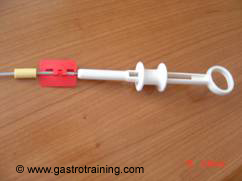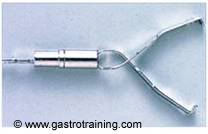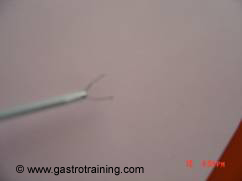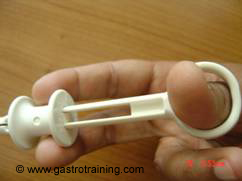Use of Endoclip
The module covers:
- When to use endoclips
- Different parts of the endoclip
- How to set it up and fire the endoclip
When to use endoclips
- Endoclip is a device commonly used to clip a bleeding vessel particularly in the context of a bleeding ulcer or a Dieulafoy lesion.
- Other uses are to achieve haemostasis in bleeding from sphincterotomy and to stop bleeding from the base of a polyp after polypectomy.
Different parts of the endoclip
An Olympus QuickClip device has been shown, however the principles are the same for all types of endosclips. It comes both for upper GI and lower GI applications.
- Starting with the tip/clip which is covered in a plastic sheath.

- The thumb-rest ring

Picture2: The yellow slider, red stopper and the firing handle- How to set it up and fire
- This is mainly operated by the endoscopy nurse but you need to know the working of the endoclip.
- Pass the tip of the endoclip which goes through the biopsy channel and make sure the red stopper is intact and the clip is retracted inside the sheath which is normally the case as you take it out of the packaging.
- The red stopper prevents the clip coming out of the sheath accidentally.
- When the endoscopist is in right position and ready to deploy the clip he will ask to open the clip. This is when you/assistant should remove the red stopper
- Pull the yellow tube towards the slider and this would bring the clip out of the sheath.

Picture3: The pulling of the yellow slider to the handle makes the clip to come out of sheath but it is not fully open to deploy yet- To get the clip in correct position the endoscopist might ask you to rotate the clip. Clip can be rotated by rotating the handle.
- When everything is ready the endoscopist pushes the clip to the vessels and ask you to fire
- Now before actually firing you will have to prime the clip
- If you look carefully there is a waist at the bottom of the clip ( making the clip to look like X rather than V) and the clip in this stage is not completely open and there is less gripping power.

Picture4: Olympus Quickclip: Courtesy Olympus- Before firing the waist need to vanish so that the clip is completely open and looks like letter V.
- The same movement which fires the clip will get rid off the bottom waist but you have to be careful not to go all the way which than will fire the clip.

Picture 5: Note that the bottom waist has vanished and clip looks like letter V- You will hear two distinct sound – the first faint click indicates the waist at the bottom is gone and the clip is ready to fire and the second louder click indicates that the clip has been fired.
- Lastly fire by pulling the handle towards the thumb rest.
Picture1: The red stopper prevent the yellow slider to move so that the clip stays in side the sheath
2. Next is the handle with the yellow slider.
3.In between the two stays the red stopper

Picture 6: The firing grip and pull the handle towards the thumb-first click means the clip is primed and the second click means the clip is fired- second click is much louder and harder
Here is the link for Endoclip video:
Acknowledgement/Bibliography:
- Tang SJ et al. Endoscopic hemostasis using endoclip in early gastrointestinal hemorrhage after gastric bypass surgery. Obesity surgery 2007; 17: 1261-1267
- Ohta S et al. Hemostasis with endoscopic hemoclipping for severe gastrointestinal bleeding in critically ill patients. Am J Gastroenterol 1996;91:701-4.
- Yoshikane H et al. Endoscopic repair by clipping of iatrogenic colonic perforation. Gastrointest Endosc 1997; 46:464-6.
- Product guide of the respective companies- Olympus









